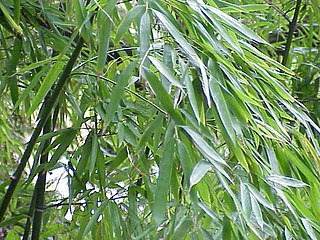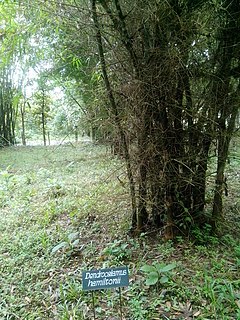
Bamboos are a diverse group of evergreen perennial flowering plants in the subfamily Bambusoideae of the grass family Poaceae. The origin of the word "bamboo" is uncertain, but it probably comes from the Dutch or Portuguese language, which originally borrowed it from Malay or Kannada.

Phyllostachys is a genus of Asian bamboo in the grass family. Many of the species are found in central and southern China, with a few species in northern Indochina and in the Himalayas. Some of the species have become naturalized in parts of Asia, Australia, the Americas, and southern Europe.

Phyllostachys nigra, commonly known as, black bamboo, is a species of bamboo, native to Hunan Province of China, and is widely cultivated elsewhere.

Phyllostachys aureosulcata, the yellow groove bamboo, is a species of bamboo native to the Zhejiang Province of China. It is a running bamboo with a distinctive yellow stripe in the culm groove that is often grown as an ornamental.
Phyllostachys heteroclada, the fishscale bamboo, also known as "water bamboo", is a running bamboo. The water bamboo name comes from the air canals in the rhizomes and roots that allow this bamboo to grow in more saturated conditions as compared to similar species. This species can also have abrupt kinks at the base of the culms. Maximum height can reach 35 ft with a diameter of 2 in. It is cold hardy to around -5 °F. It grows well in USDA zones 6b-10.

Bambusa tulda, or Indian timber bamboo, is considered to be one of the most useful of bamboo species. It is native to the Indian subcontinent, Indochina, Tibet, and Yunnan, and naturalized in Iraq, Puerto Rico, and parts of South America.
Phyllostachys atrovaginata is a running bamboo with strongly tapered, stiff, upright culms. It may reveal a fragrant scent during warm weather or when vigorously rubbed. The common name of "incense bamboo" comes from the unique aroma. Its culms grow large in diameter relative to height. Maximum height can reach 10 m (33 ft) with a maximum culm diameter of 7.0 cm (2.7 in). This bamboo grows in areas ranging from subtropical to temperate and tolerates winter temperatures down to -23 °C (-10 °F), being a more cold-hardy bamboo. Like water bamboo, the rhizomes and roots of this species also have air canals as an adaptation for living in wet soil. The specific epithet atrovaginata or "dark-sheathed" is inspired from the dark green and deep red wine colors of the culm sheaths. P. atrovaginata has formerly been called Phyllostachys congesta.

Phyllostachys rubromarginata, the reddish bamboo or red margin bamboo, is a species of Phyllostachys bamboo, native to Central China, specifically Guangxi and Guizhou.

Bambusa lako, known as Timor black bamboo, is a large species of bamboo originating from the island of Timor; its black culms may reach 21 m (69 ft) in height. A 2000 molecular study places it as closely related to the similar Indonesian species Gigantochloa atroviolacea, from which it was separated in 1997; it may soon be placed in that genus. Bambusa lako can only be grown in climates that are mostly frost free.

Phyllostachys parvifolia is a running bamboo with thick culms that grow tall for a bamboo that endures cold weather.

Dendrocalamus strictus is a bamboo species belonging to the Dendrocalamus genus. The culms (stems) are often solid. Common names include male bamboo, solid bamboo, and Calcutta bamboo.

Phyllostachys edulis, the mōsō bamboo, or tortoise-shell bamboo, or mao zhu, is a temperate species of giant timber bamboo native to China and Taiwan and naturalised elsewhere, including Japan where it is widely distributed south of Hokkaido. The edulis part of the Latin name refers to its edible shoots. This bamboo can reach heights of up to 28 m (92 ft). This particular species of bamboo is the most common species used in the bamboo textile industry of China, for the production of rayon.

Phyllostachys aurea is a species of bamboo, and is of the 'running bamboo' type, belonging to the diverse Bambuseae tribe. It is native to Fujian and Zhejiang in China. It is commonly known by the names fishpole bamboo, golden bamboo, monk's belly bamboo, and fairyland bamboo (Australia).

Bambusa bambos, the giant thorny bamboo, Indian thorny bamboo, spiny bamboo, or thorny bamboo, is a species of clumping bamboo native to southern Asia. It is also naturalized in Seychelles, Central America, West Indies, Java, Malaysia, Maluku, and the Philippines.

Fargesia murielae, the umbrella bamboo, is a species of flowering plant in the family Poaceae. It is a large, clump-forming evergreen bamboo, closely resembling Fargesia nitida in the same genus, but with yellow canes.

Phyllostachys bambusoides, commonly called madake, giant timber bamboo, or Japanese timber bamboo, is a species of flowering plant in the bamboo subfamily of the grass family Poaceae, native to China, and possibly also to Japan.

Bambusa chungii, commonly known as white bamboo or tropical blue bamboo, is a large, tall bamboo species, often found in Hong Kong, and originating in southern China and Vietnam. Its blue-green or white culms often reach a height of 10 m.

Dendrocalamus hamiltonii, or Hamilton's bamboo, is a species of bamboo, 12–15 cm in diameter and growing up to 15–18 m in height, found in South Asian countries such as, India, Sri Lanka, Bhutan, Nepal, Pakistan, and far eastern China.
Dendrocalamus giganteus, commonly known as giant bamboo, is a giant tropical and subtropical, dense-clumping species native to Southeast Asia. It is one of the largest bamboo species in the world.

Bambusa polymorpha, or Burmese bamboo, is a species of clumping bamboo native to Bangladesh, Laos, Myanmar, Thailand, Sri Lanka, Java, Cuba, Puerto Rico, and Ecuador.
















